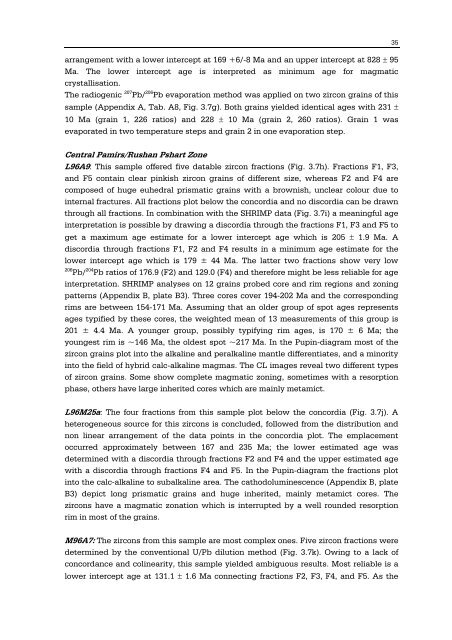tübinger geowissenschaftliche arbeiten (tga) - TOBIAS-lib ...
tübinger geowissenschaftliche arbeiten (tga) - TOBIAS-lib ...
tübinger geowissenschaftliche arbeiten (tga) - TOBIAS-lib ...
Create successful ePaper yourself
Turn your PDF publications into a flip-book with our unique Google optimized e-Paper software.
arrangement with a lower intercept at 169 +6/-8 Ma and an upper intercept at 828 � 95<br />
Ma. The lower intercept age is interpreted as minimum age for magmatic<br />
crystallisation.<br />
The radiogenic 207 Pb/ 206 Pb evaporation method was applied on two zircon grains of this<br />
sample (Appendix A, Tab. A8, Fig. 3.7g). Both grains yielded identical ages with 231 �<br />
10 Ma (grain 1, 226 ratios) and 228 � 10 Ma (grain 2, 260 ratios). Grain 1 was<br />
evaporated in two temperature steps and grain 2 in one evaporation step.<br />
Central Pamirs/Rushan Pshart Zone<br />
L96A9: This sample offered five datable zircon fractions (Fig. 3.7h). Fractions F1, F3,<br />
and F5 contain clear pinkish zircon grains of different size, whereas F2 and F4 are<br />
composed of huge euhedral prismatic grains with a brownish, unclear colour due to<br />
internal fractures. All fractions plot below the concordia and no discordia can be drawn<br />
through all fractions. In combination with the SHRIMP data (Fig. 3.7i) a meaningful age<br />
interpretation is possible by drawing a discordia through the fractions F1, F3 and F5 to<br />
get a maximum age estimate for a lower intercept age which is 205 � 1.9 Ma. A<br />
discordia through fractions F1, F2 and F4 results in a minimum age estimate for the<br />
lower intercept age which is 179 ± 44 Ma. The latter two fractions show very low<br />
206 204<br />
Pb/ Pb ratios of 176.9 (F2) and 129.0 (F4) and therefore might be less reliable for age<br />
interpretation. SHRIMP analyses on 12 grains probed core and rim regions and zoning<br />
patterns (Appendix B, plate B3). Three cores cover 194-202 Ma and the corresponding<br />
rims are between 154-171 Ma. Assuming that an older group of spot ages represents<br />
ages typified by these cores, the weighted mean of 13 measurements of this group is<br />
201 ± 4.4 Ma. A younger group, possibly typifying rim ages, is 170 ± 6 Ma; the<br />
youngest rim is ~146 Ma, the oldest spot ~217 Ma. In the Pupin-diagram most of the<br />
zircon grains plot into the alkaline and peralkaline mantle differentiates, and a minority<br />
into the field of hybrid calc-alkaline magmas. The CL images reveal two different types<br />
of zircon grains. Some show complete magmatic zoning, sometimes with a resorption<br />
phase, others have large inherited cores which are mainly metamict.<br />
L96M25a: The four fractions from this sample plot below the concordia (Fig. 3.7j). A<br />
heterogeneous source for this zircons is concluded, followed from the distribution and<br />
non linear arrangement of the data points in the concordia plot. The emplacement<br />
occurred approximately between 167 and 235 Ma; the lower estimated age was<br />
determined with a discordia through fractions F2 and F4 and the upper estimated age<br />
with a discordia through fractions F4 and F5. In the Pupin-diagram the fractions plot<br />
into the calc-alkaline to subalkaline area. The cathodoluminescence (Appendix B, plate<br />
B3) depict long prismatic grains and huge inherited, mainly metamict cores. The<br />
zircons have a magmatic zonation which is interrupted by a well rounded resorption<br />
rim in most of the grains.<br />
M96A7: The zircons from this sample are most complex ones. Five zircon fractions were<br />
determined by the conventional U/Pb dilution method (Fig. 3.7k). Owing to a lack of<br />
concordance and colinearity, this sample yielded ambiguous results. Most reliable is a<br />
lower intercept age at 131.1 � 1.6 Ma connecting fractions F2, F3, F4, and F5. As the<br />
35

















